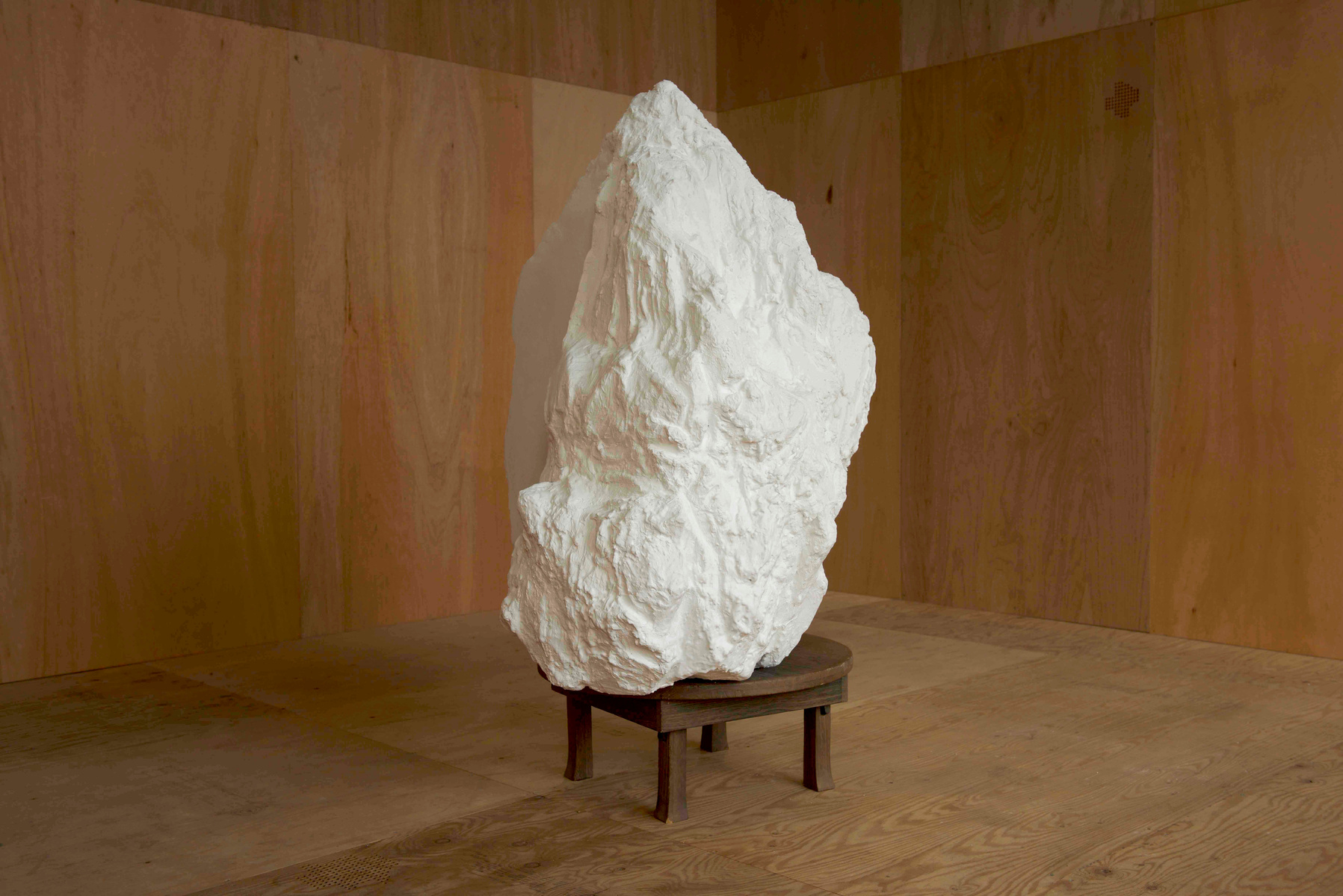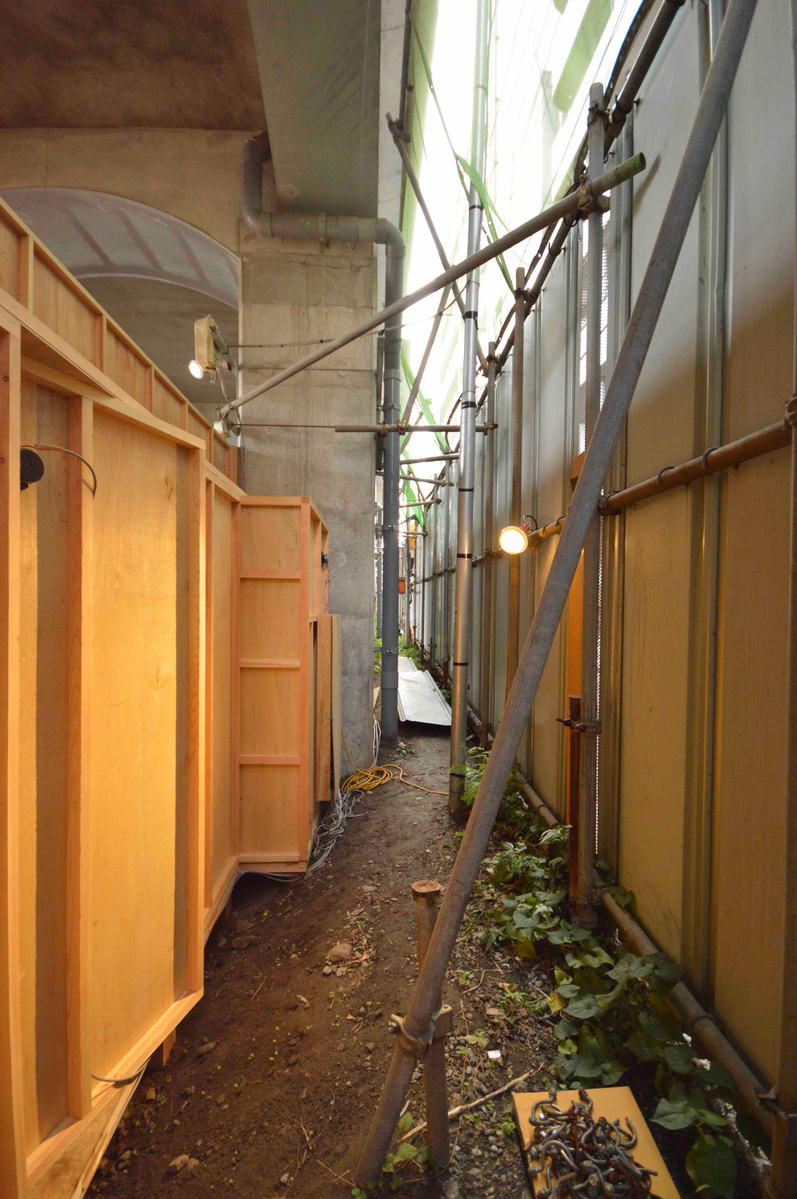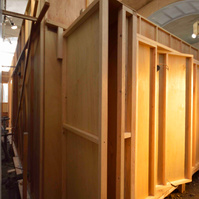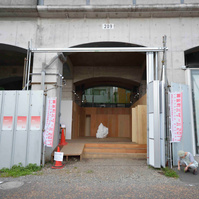3:01
3:01
2017
Site-specific architectural intervention and 12-channel sound installation in Koganecho area, Yokohama, Japan
Sound duration: 07:34 min (Played in loop with a break of 3:01 min)
I realized <3:01> during my stay at the Koganecho residency program in Yokohama, Japan.
With this site-specific project I wanted to discuss the tension between scenery and the everyday life; the relation between narration, deception and „the real story“.
The area „Koganecho“ is known for its history as a red-light district and as a place of notorious organized crime. It was kind of a forbidden place for people coming from „good homes“ and was watched with curiosity from the other side of the river bank.
The elevated railway dominates and structures the area. When the trains pass by, the old two-floor houses, which line up on both sides of the elevated railroad tracks are shaking. The style of the houses indicates their initial special functions (as brothels, etc.).
The space underneath the elevated railway, remains mostly empty and was fenced by the city government, to avoid the entry of the public.
>>Transformation: space & sound
This context interested me. I decided to develop my project in this special semi-public space.
A temporary exhibition venue was built underneath the elevated railway.
In context with this area, I developed a 12-channel sound installation.
>>central stage and 4 extra spaces
I transformed the exhibition venue spatially during the exhibition.
The exhibition had two main opening events, which were held with a 6 week gap. At the first opening, I presented a metaphorical icon in the middle of the stage-like theatrical venue: a stone-like plaster sculpture stood on a traditional Japanese tea table, that I found in Koganecho.
After the first opening I began to change the limited given exhibition space. In this period, a total of 4 extra rooms was added. I removed some of the wooden construction elements and extended the closed theatrical stage.The audience could enter four different extended spaces through the former central main stage. Each room would offer the audience another spatial experience by its different construction design and soundcollage.
I called the 4 new spaces: „The Exit at Cat Street“; „Inclined roof cabinet and the Star see-saw“; „Infinite Gar-den behind the Paravent“; and „the Outsider“.
The construction design was based on and inspired by local architecture, which shows efficient usage for unexpected space.
In „Infinite Garden behind the Paravent“ I created a small garden. Here, various kinds of plants were growing together. Some of them were cultivated by me, but most of them were lend by the neighbors in a participatory gesture forthis period. During my stay I took interviews with people that run gathering places like bars and restaurants in this area to help me to understand this area better by hearing about their living experiences. In the end I asked them if they would borrow me one of their plants to create this garden.
>>Soundscapes: from the channelsand from the present environment
As the space evolved, more and more additional sound channels were added to the installation.
In the multi-channel sound installation you could hear a composition of soundscapes, which I perceived and recorded in the Koganecho area. The sound collage came out from the different-positioned speakers, that I embed-ded into the thin wooden walls, doors and ceilings. They were like a choir; singing together. They showed different rhythms and generated a dramatization together.
The present environmental soundscapes flow into the temporary exhibition space, integrated into the sound installation, and become a part of it. Through the overlapping of the ever present and the past, I let reality and fiction intertwine. Construction and deconstruction. The real soundscape and the loud speakers mounted behind the thin woodenboards of the exhibition architectureturn the space into a resonator and let the visitors experience the place physically and sensually. The Sounds connect the space and show the space.
Special thanks to all the neighbors, who generously contributed to the work by temporarily donating their plants and giving me an insight of their experience of running gathering places in the Koganecho area:
Honey & Spice Coffee Shop, Yizumiya Restaurant, Tatsuya Ramen Shop , Saiko San, Kumasawa San, JungFuKu Coffee Shop, Namaste Curry Shop, Laugh Park Bar, Kurihara San.
>>Koganecho Area (Yokohama, Japan)
































